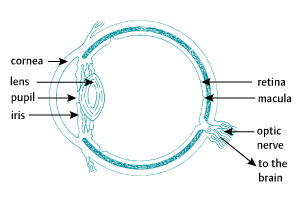Symptoms
Symptoms vary from person to
person, but usually the first
problems people notice are with
their ability to see detail. You may
have problems reading small print,
even if you wear your usual reading
glasses, or you may find that there
is a slight smudge in your sight or
that your vision has a small blurred
area in the centre. Straight lines
may look distorted or wavy or as if
there's a little bump in them. You
may also find you become sensitive
to bright light or that you see
shapes and lights that aren't
actually there. Sometimes people may
only notice these changes in one
eye.
You should have your eyes tested
by an optometrist (optician) if:
- you notice any difficulty
with reading small print with
your reading glasses
- straight lines start to look
wavy or distorted
- your vision isn't as clear
as it used to be.
The optometrist will be able to
measure any changes in your vision
and examine the back of your eye. If
they detect any changes to your
macula or any cause for concern they
will arrange an appointment with the
ophthalmologist (hospital eye
consultant) for further tests.
The macula
AMD affects the macula area of
the retina. The macula is a tiny
area of your retina which is very
important for seeing detail, colour
and things directly in front of you.

When the light enters your eye it
is focused onto your retina at the
back of your eye. The retina
includes a number of layers but the
most important for vision is a layer
made up of cells called
photoreceptors. Photoreceptors are
cells which are sensitive to light.
The macula, which is about the
size of a pinhead, is a specialised
area of the retina that contains a
few million specialised
photoreceptor cells called cone
cells. These cone cells function
best in bright light levels and
allow you to see fine detail for
activities such as reading and
writing and to recognise colours.
Away from the central macula is
the peripheral retina, composed
mostly of the other type of
photoreceptor called rod cells. They
enable us to see when light is dim
and provide peripheral (side) vision
outside of the main line of sight.
Peripheral vision is the sight you
have out of the corner of your eye
when looking straight ahead.
When someone develops AMD, the
cone cells in the macula area become
damaged and stop working as well as
they should.
Types of AMD
There are two main types of AMD -
"wet" AMD and "dry" AMD. They are
called "wet" and "dry" because of
what happens inside your eye and
what the ophthalmologist (hospital
eye doctor) sees when examining the
inside of your eye, not because of
how the eye feels or whether you
have a watery or dry eye.
Dry AMD
Dry AMD is the more common type
of AMD. It usually develops very
slowly and causes a gradual change
in your central vision. Dry AMD
usually takes a long time, maybe a
number of years to get to its final
stage. At its worst, dry AMD causes
a blank patch in the centre of your
vision in both of your eyes. But it
doesn't affect your peripheral
vision, so never leads to total
blindness.
Wet AMD
About 10-15 per cent of people
who develop AMD have wet AMD. You
develop wet AMD when the cells of
the macula stop working correctly
and the body starts growing new
blood vessels to fix the problem.
Unfortunately, these blood vessels
grow in the wrong place and cause
swelling and bleeding underneath the
macula. This new blood vessel
growth, medically known as neo-vascularisation,
causes more damage to your macula
and eventually leads to scarring.
Both the new blood vessels and the
scarring damages your central vision
and may lead to a blank patch in the
centre of your sight.
Wet AMD can develop very quickly,
making serious changes to your
central vision in a short period of
time. Treatment is now available for
wet AMD, which stops the new blood
vessels from growing and damaging
your macula. This treatment usually
needs to be given quickly before the
new blood vessels do too much damage
to your macula. If the blood vessels
are left to grow, the scarring and
the sight loss it causes is usually
permanent. Wet AMD doesn't affect
your peripheral vision, so it
doesn't lead to total blindness.
Both types of AMD
Wet and dry AMD have things in
common. They usually affect both
your eyes, though sometimes one eye
may be affected long before the
other. Both wet and dry AMD only
affect your central vision and won't
affect your vision around the edge
of your sight. So neither type of
AMD will cause you to lose all your
sight.
Some people diagnosed with dry
AMD find that, with time, new blood
vessels grow and they develop wet
AMD. If you have dry AMD and your
sight suddenly changes you should
always have this checked by your
ophthalmologist (hospital eye
doctor).
Some people may have wet AMD in
one eye and have dry AMD in the
other which doesn't develop into wet
AMD. Most people, however, have the
same type of AMD in both eyes.
Confusingly, people who have had
wet AMD for a long time, causing bad
scarring on their retina, may be
told that their wet AMD has "dried
up". This usually means that there
are no new blood vessels growing and
that your macula has been badly
scarred. At this stage of wet AMD,
the treatments available wouldn't
help.
AMD is not painful and it never
leads to a complete loss of vision.
Most people with AMD keep their
peripheral vision (everything around
the edge). This peripheral vision
will mean that you should still be
able to get around on your own and
make use of this vision everyday.